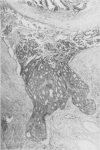Abstract
We reviewed the pathology of 81 malignant colorectal polyps in 80 patients treated by endoscopic polypectomy and assessed the importance of carcinomatous invasion of veins in the stalk (submucosa). All the patients were followed up for at least five years. Venous invasion was present in 30 of the polyps (37%). The histological features of lymphatic invasion were considered too subjective to be of value. Most of the tumours were well or moderately differentiated adenocarcinomas, one was poorly differentiated, and one was a signet ring cell carcinoma. Seventy one patients were treated by polypectomy alone, and 58 of these were alive and well five years later, with no evidence of recurrence. Nine died of unrelated causes within five years, but four died of carcinomatosis: one with recurrent tumour, one with a possible metachronous caecal cancer, and in two patients there was late development of malignancy of uncertain nature. The remaining nine patients underwent surgical resection after initial endoscopic polypectomy because of incompleteness of excision, poor differentiation of the tumour, or a decision by the surgeon. Tumour was not present in the resection specimens apart from a single lymph node deposit in the patient with signet ring cell carcinoma. These nine patients were alive and well without evidence of recurrence five years later. The results reemphasize the necessity of good cooperation between endoscopist and pathologist, meticulous laboratory technique, strict histopathological criteria including examination of resection margins and degree of differentiation of the tumour, and regular endoscopic follow up. Endoscopic polypectomy of pedunculated and sessile malignant polyps is adequate treatment if the lesion can be removed in one piece, the tumour is well or moderately differentiated, and local excision is judged complete by endoscopic and histological criteria. Patients with histologically incompletely excised polyps, containing well or moderately differentiated carcinoma, can be safely managed by conservative treatment provided the endoscopist is certain there is no residual tumour. Venous invasion by tumour is a common finding in malignant colorectal polyps and seems to have no prognostic importance.
Full text
PDF




Images in this article
Selected References
These references are in PubMed. This may not be the complete list of references from this article.
- Christie J. P. Polypectomy or colectomy? Management of 106 consecutively encountered colorectal polyps. Am Surg. 1988 Feb;54(2):93–99. [PubMed] [Google Scholar]
- Colacchio T. A., Forde K. A., Scantlebury V. P. Endoscopic polypectomy: inadequate treatment for invasive colorectal carcinoma. Ann Surg. 1981 Dec;194(6):704–707. doi: 10.1097/00000658-198112000-00008. [DOI] [PMC free article] [PubMed] [Google Scholar]
- Cooper H. S. Surgical pathology of endoscopically removed malignant polyps of the colon and rectum. Am J Surg Pathol. 1983 Oct;7(7):613–623. doi: 10.1097/00000478-198310000-00002. [DOI] [PubMed] [Google Scholar]
- Coverlizza S., Risio M., Ferrari A., Fenoglio-Preiser C. M., Rossini F. P. Colorectal adenomas containing invasive carcinoma. Pathologic assessment of lymph node metastatic potential. Cancer. 1989 Nov 1;64(9):1937–1947. doi: 10.1002/1097-0142(19891101)64:9<1937::aid-cncr2820640929>3.0.co;2-x. [DOI] [PubMed] [Google Scholar]
- Cranley J. P., Petras R. E., Carey W. D., Paradis K., Sivak M. V. When is endoscopic polypectomy adequate therapy for colonic polyps containing invasive carcinoma? Gastroenterology. 1986 Aug;91(2):419–427. doi: 10.1016/0016-5085(86)90577-9. [DOI] [PubMed] [Google Scholar]
- Fielding L. P., Phillips R. K., Hittinger R. Factors influencing mortality after curative resection for large bowel cancer in elderly patients. Lancet. 1989 Mar 18;1(8638):595–597. doi: 10.1016/s0140-6736(89)91618-8. [DOI] [PubMed] [Google Scholar]
- Grossman S., Milos M. L., Tekawa I. S., Jewell N. P. Colonoscopic screening of persons with suspected risk factors for colon cancer: II. Past history of colorectal neoplasms. Gastroenterology. 1989 Feb;96(2 Pt 1):299–306. doi: 10.1016/0016-5085(89)91551-5. [DOI] [PubMed] [Google Scholar]
- Haggitt R. C., Glotzbach R. E., Soffer E. E., Wruble L. D. Prognostic factors in colorectal carcinomas arising in adenomas: implications for lesions removed by endoscopic polypectomy. Gastroenterology. 1985 Aug;89(2):328–336. doi: 10.1016/0016-5085(85)90333-6. [DOI] [PubMed] [Google Scholar]
- Jass J. R., Love S. B. Prognostic value of direct spread in Dukes' C cases of rectal cancer. Dis Colon Rectum. 1989 Jun;32(6):477–480. doi: 10.1007/BF02554501. [DOI] [PubMed] [Google Scholar]
- Morson B. C. Factors influencing the prognosis of early cancer of the rectum. Proc R Soc Med. 1966 Jul;59(7):607–608. doi: 10.1177/003591576605900710. [DOI] [PMC free article] [PubMed] [Google Scholar]
- Morson B. C., Whiteway J. E., Jones E. A., Macrae F. A., Williams C. B. Histopathology and prognosis of malignant colorectal polyps treated by endoscopic polypectomy. Gut. 1984 May;25(5):437–444. doi: 10.1136/gut.25.5.437. [DOI] [PMC free article] [PubMed] [Google Scholar]
- Muller S., Chesner I. M., Egan M. J., Rowlands D. C., Collard M. J., Swarbrick E. T., Newman J. Significance of venous and lymphatic invasion in malignant polyps of the colon and rectum. Gut. 1989 Oct;30(10):1385–1391. doi: 10.1136/gut.30.10.1385. [DOI] [PMC free article] [PubMed] [Google Scholar]
- Phillips R. K., Hittinger R., Blesovsky L., Fry J. S., Fielding L. P. Large bowel cancer: surgical pathology and its relationship to survival. Br J Surg. 1984 Aug;71(8):604–610. doi: 10.1002/bjs.1800710813. [DOI] [PubMed] [Google Scholar]
- Rossini F. P., Ferrari A., Spandre M., Coverlizza S. Coloscopic polypectomy in diagnosis and management of cancerous adenomas: an individual and multicentric experience. Endoscopy. 1982 Jul;14(4):124–127. doi: 10.1055/s-2007-1021598. [DOI] [PubMed] [Google Scholar]
- Sasaki O., Atkin W. S., Jass J. R. Mucinous carcinoma of the rectum. Histopathology. 1987 Mar;11(3):259–272. doi: 10.1111/j.1365-2559.1987.tb02631.x. [DOI] [PubMed] [Google Scholar]
- Talbot I. C., Ritchie S., Leighton M., Hughes A. O., Bussey H. J., Morson B. C. Invasion of veins by carcinoma of rectum: method of detection, histological features and significance. Histopathology. 1981 Mar;5(2):141–163. doi: 10.1111/j.1365-2559.1981.tb01774.x. [DOI] [PubMed] [Google Scholar]
- Wilcox G. M., Anderson P. B., Colacchio T. A. Early invasive carcinoma in colonic polyps. A review of the literature with emphasis on the assessment of the risk of metastasis. Cancer. 1986 Jan 1;57(1):160–171. doi: 10.1002/1097-0142(19860101)57:1<160::aid-cncr2820570132>3.0.co;2-n. [DOI] [PubMed] [Google Scholar]
- Wolff W. I., Shinya H. Definitive treatment of "malignant" polyps of the colon. Ann Surg. 1975 Oct;182(4):516–525. doi: 10.1097/00000658-197510000-00018. [DOI] [PMC free article] [PubMed] [Google Scholar]



